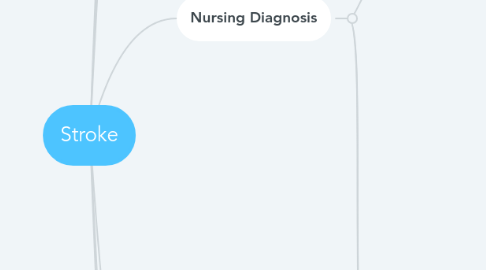
1. Signs & Symptoms
1.1. The main signs and symptoms would be a facial drop, arm weakness, and slurred speech. While these are the main signs and symptoms of stroke, there can be other signs and symptoms as well. These include numbness, confusion, sudden mobile impairments, severe headache, or trouble seeing.
2. Causes
2.1. A stroke is caused by loss of blood perfusion to the brain. This can be due to a blockage (ischemia) or hemorrhage. Risk factors for stroke contribute greatly to the cause of the stroke.
2.2. Risk factors
2.2.1. There are modifiable and non modifiable risk factors for stroke. The modifiable risk factors include smoking, hypertension, diabetes, diet, physical activity, diet, and elevated cholesterol. The non modifiable risk factors are age, family history, race, gender, and medical history.
3. Diagnostics
3.1. The main test used to diagnose a stroke is a CT or CAT scan. It uses radiation to take a picture of the brain. These test can tell healthcare staff where the stroke is located, and what is the cause of the stroke was (ischemic or hemorrhagic). Another diagnostic test would be an MRI. This test is a lot like eh CT scan, it produces in image of the brain that shows the location and type of stroke. The MRI shows sharper images than the CT scan. Therefore, it is often used for small or deep injuries. The last diagnostic test is the CTA (computed tomographic angiography). A contrast dye is injected into the vein. Then images are taken to look for abnormalities.
4. Patient Education
4.1. Patients should be educated based off of the causes and effects of their stroke. For instance, if diabetes is believed to cause the stroke, then the patient may need information on how to manage diabetes. If weakness and dysfunction are effects of the stroke, the patient may need physical therapy and occupational therapy to relearn ADLs.
5. Nursing Diagnosis
5.1. 1) At risk for falls due to neuromuscular
5.1.1. Subjective Data: Patient stated being dizzy at times. Patient also stated being unbalanced. Patient reported a previous fall. Patient reports needing a walker, but not wanting to use one.
5.1.2. Objective Data: Patient has hemianopsia. Patient also walks slowly and has an unbalanced gait. Patient takes frequent breaks when walking. Patient also gets short of breath when walking.
5.1.3. Short Term Goals: Patient will remain free of fall during hospital stay. Patient will be able to state when he needs to use his walker. Patient will state when walker is needed. Long Term Goals: Patient will not report any falls within the next three months. Patient will not have short of breath when they are walking within the next three months. Patient will be able to walk one mile 6 months after cerebral event.
5.1.4. Interventions and Rationales
5.1.4.1. Intervention: Evaluate the client's medications to determine whether medications increase the risk of falling; consult with health care provider regarding the client's need for medication if appropriate.
5.1.4.1.1. Rationale: Polypharmacy, or taking more than four medications, has been associated with increased falls. (Capezuti et al, 1999; Goodwin et al, 2014).
5.1.4.2. Intervention: Assess home environment for threats to safety including clutter, slippery floors, scatter rugs, and other potential hazards. Additionally, assess external environment (e.g., uneven pavement, unleveled stairs/steps).
5.1.4.2.1. Rationale: Clients suffering from impaired mobility, impaired visual acuity, and neurological dysfunction, including dementia and other cognitive functional deficits, are all at risk for injury from common hazards. (Goodwin et al, 2014).
5.1.4.3. Intervention: Instruct the client and family or caregivers on how to correct identified hazards for those with visual impairment. Refer to physical and occupational therapy services for assistance if needed.
5.1.4.3.1. Rationale: Interventions to improve home safety were shown to be effective in people at high risk, such as those with severe visual impairment (Gillespie et al, 2009).
5.1.5. Evaluation
5.1.5.1. Short Term: If these goals were not met, I would assess patient for an injury related to fall. I would also ask the doctor for additional help from OT and PT. Lastly, I would review patient status before fall to see if anything has changed. If patient was not by nurses station, I would move patient to room by nurses station. I would also ensure fall precautions were in place.
5.1.5.2. Long Term: If these goals were not met, I would see if patient could benefit from oxygen. I would also see if patient was eligible for an exercise class for elder adults. This class may help patient with endurance and strength.

